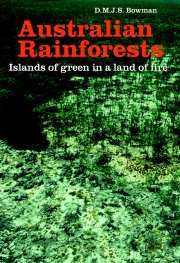Book contents
- Frontmatter
- Contents
- Preface
- 1 Introduction
- 2 What is Australian rainforest?
- 3 The sclerophyll problem
- 4 The edaphic theory I. The control of rainforest by soil phosphorus
- 5 The edaphic theory II. Soil types, drainage, and fertility
- 6 The climate theory I. Water stress
- 7 The climate theory II. Light and temperature
- 8 The fire theory I. Field evidence
- 9 The fire theory II. Fire, nutrient cycling, and topography
- 10 The fire theory III. Fire frequency, succession, and ecological drift
- 11 The fire theory IV. Aboriginal landscape burning
- 12 The fire theory V. Aridity and the evolution of flammable forests
- 13 The fire theory VI. Fire management and rainforest conservation
- 14 Summary
- References
- Index
12 - The fire theory V. Aridity and the evolution of flammable forests
Published online by Cambridge University Press: 23 November 2009
- Frontmatter
- Contents
- Preface
- 1 Introduction
- 2 What is Australian rainforest?
- 3 The sclerophyll problem
- 4 The edaphic theory I. The control of rainforest by soil phosphorus
- 5 The edaphic theory II. Soil types, drainage, and fertility
- 6 The climate theory I. Water stress
- 7 The climate theory II. Light and temperature
- 8 The fire theory I. Field evidence
- 9 The fire theory II. Fire, nutrient cycling, and topography
- 10 The fire theory III. Fire frequency, succession, and ecological drift
- 11 The fire theory IV. Aboriginal landscape burning
- 12 The fire theory V. Aridity and the evolution of flammable forests
- 13 The fire theory VI. Fire management and rainforest conservation
- 14 Summary
- References
- Index
Summary
In this book, I have sought to establish that the boundaries between rainforest and non-rainforest vegetation are determined by the frequency of wildfire. This generalisation holds across a latitudinal gradient from12° S in the monsoon tropics to 44° S in Tasmania and includes all rainforest environments on the east coast of Australia. Indeed, in arid Australia fire also delimits the boundaries of small patches of woody vegetation that have taxonomic links to ‘rainforest’, such as Callitris-dominated communities (Bowman 1992b; Bowman and Latz 1993). The importance of fire in dichotomising the ecology of Australian forests was clearly enunciated by Webb (1968). He wrote that it is possible to ‘regard the Australian forest flora as composed of species ranging from extremely fire-sensitive to fire tolerant, which have been sifted by fire as an evolutionary factor to produce two major classes of vegetation: one whose existence depends on protection from fire, and the other which is able to survive or regenerate in different degrees after burning’. The purpose of this chapter is to explore the historical reasons for this ecological divergence. First, I will briefly describe the environmental history of Australian vegetation by reference to the abiotic and biotic evidence. I will then critically consider evolutionary models that account for the diaspora of the habitat islands of fire-sensitive rainforest in vast tracts of flammable forests.
- Type
- Chapter
- Information
- Australian RainforestsIslands of Green in a Land of Fire, pp. 250 - 278Publisher: Cambridge University PressPrint publication year: 2000



